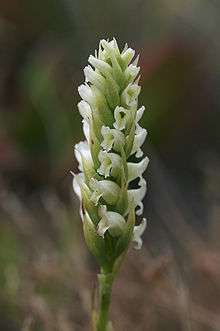Spiranthes romanzoffiana
Spiranthes romanzoffiana, commonly known as hooded lady's tresses[1] (alternatively hooded ladies' tresses[2]) or Irish lady's-tresses,[3] is a species of orchid. Collected by Chamisso during the Romanzov expedition it was described by him in 1828 and named for Count Nikolay Rumyantsev who financed the expedition. This orchid is native to North America, Ireland and the British Isles.[4]
_(19129011643).jpg)
| Spiranthes romanzoffiana | |
|---|---|
 | |
| Scientific classification | |
| Kingdom: | Plantae |
| Clade: | Tracheophytes |
| Clade: | Angiosperms |
| Clade: | Monocots |
| Order: | Asparagales |
| Family: | Orchidaceae |
| Subfamily: | Orchidoideae |
| Tribe: | Cranichideae |
| Subtribe: | Spiranthinae |
| Genus: | Spiranthes |
| Species: | S. romanzoffiana |
| Binomial name | |
| Spiranthes romanzoffiana | |
| Synonyms | |
| |
Description
Hooded lady's tresses is a perennial plant with a fleshy rootstock. It sends up shoots with lanceolate leaves and three rows of flowers arranged in spirally twisted rows. Each scented flower has the sepals and petals united forming a lip of a tube. The labellum, or lower petal, of the flower is white with green veins.[5][6]
The plant flowers in late summer. The flowers are pollinated by insects, and the tiny dust-like seed is distributed by the wind. However the plant can also reproduce vegetatively by means of root tubers which can grow new shoots while the old parts of the plant die. The orchid is associated with a mycorrhizal fungus which can provide it with essential nutrients.[6]
Distribution and habitat
Hooded ladies' tresses was first described by the German botanist Adelbert von Chamisso. He named it in honour of his patron Nikolay Rumyantsev who had financed the scientific exploration to the Americas in 1815–1818 on which he found the orchid. It is common in North America, including Canada and the United States, but also grows in a few locations in Scotland, England, and Ireland.[2] The first Irish record was made in 1810 in County Cork.[7] Since then it has been found in a number of other locations in Ireland and Northern Ireland, including the Lough Neagh basin and the Mourne Mountains and the hills of Antrim.[6] It grows along lakeshores and in damp pastures.[5] The distribution pattern, occurring on both sides of the Atlantic Ocean, is puzzling.[8]
References
- "Spiranthes romanzoffiana". Natural Resources Conservation Service PLANTS Database. USDA. Retrieved 27 November 2015.
- "Spiranthes romanzoffiana (Hooded Ladies' Tresses)". goorchids.northamericanorchidcenter.org. Go Orchids. Retrieved 2018-11-09.
- "BSBI List 2007". Botanical Society of Britain and Ireland. Archived from the original (xls) on 2015-01-25. Retrieved 2014-10-17.
- "World Checklist of Selected Plant Families".
- Parnell, J. and Curtis, T. 2012. Webb's An Irish Flora. Cork University Press. ISBN 978-185918-4783
- "Spiranthes romanzoffiana – Irish lady's-tresses". Northern Ireland Priority Species. Retrieved 19 March 2020.
- Hackney,P. Ed. 1992. Stewart & Corry's Flora of the North-east of Ireland. Third edition. Institute of Irish Studies, The Queen's University of Belfast ISBN 0-85389-446-9
- Dunn, Jon (2018). Orchid Summer: In Search of the Wildest Flowers of the British Isles. Bloomsbury Publishing. pp. 389–392. ISBN 978-1-4088-8090-6.
- Correll, D.S., Native Orchids of North America, p. 220. 1978.
Further references
- Horsman, F. 2013. The discovery and subsequent history of Spiranthes romanzoffiana Chamisso (Orchidaceae) at Castletown Bearhaven in West Cork (H3) Irish Naturalists' Journal 32 19 - 25.